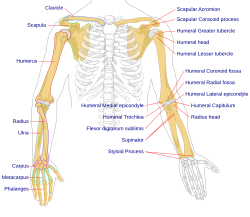| Arm | |
|---|---|
 The left arm of a human male | |
| Details | |
| Artery | Axillary artery |
| Vein | Axillary vein |
| Nerve | Brachial plexus |
| Identifiers | |
| Latin | brachium |
| Anatomical terminology | |
In human anatomy, the arm refers to the upper limb in common usage, although academically the term specifically means the upper arm [1] [2] between the glenohumeral joint (shoulder joint) and the elbow joint. The distal part of the upper arm between the elbow and the radiocarpal joint (wrist joint) is known as the forearm or "lower" arm, and the extremity beyond the wrist is the hand.
Contents
- Structure
- Bones
- Muscles
- Nerve supply
- Blood supply
- Veins
- Society and culture
- Clinical significance
- Other animals
- Additional images
- See also
- References
By anatomical definitions, the bones, ligaments and skeletal muscles of the shoulder girdle, as well as the axilla between them, are considered parts of the upper limb, and thus also components of the arm. The Latin term brachium, which serves as a root word for naming many anatomical structures, may refer to either the upper arm as a whole or to the upper arm on its own. [3] [4] [5]





